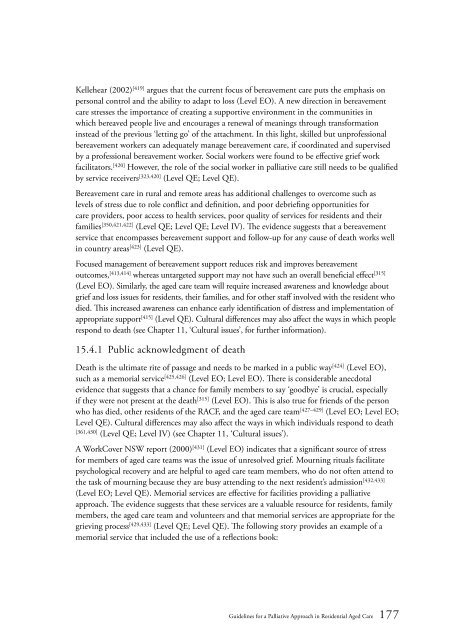Guidelines for a Palliative Approach in Residential Aged Care
Guidelines for a Palliative Approach in Residential Aged Care
Guidelines for a Palliative Approach in Residential Aged Care
You also want an ePaper? Increase the reach of your titles
YUMPU automatically turns print PDFs into web optimized ePapers that Google loves.
Kellehear (2002) [419] argues that the current focus of bereavement care puts the emphasis on<br />
personal control and the ability to adapt to loss (Level EO). A new direction <strong>in</strong> bereavement<br />
care stresses the importance of creat<strong>in</strong>g a supportive environment <strong>in</strong> the communities <strong>in</strong><br />
which bereaved people live and encourages a renewal of mean<strong>in</strong>gs through trans<strong>for</strong>mation<br />
<strong>in</strong>stead of the previous ‘lett<strong>in</strong>g go’ of the attachment. In this light, skilled but unprofessional<br />
bereavement workers can adequately manage bereavement care, if coord<strong>in</strong>ated and supervised<br />
by a professional bereavement worker. Social workers were found to be effective grief work<br />
facilitators. [420] However, the role of the social worker <strong>in</strong> palliative care still needs to be qualified<br />
by service receivers [323,420] (Level QE; Level QE).<br />
Bereavement care <strong>in</strong> rural and remote areas has additional challenges to overcome such as<br />
levels of stress due to role conflict and def<strong>in</strong>ition, and poor debrief<strong>in</strong>g opportunities <strong>for</strong><br />
care providers, poor access to health services, poor quality of services <strong>for</strong> residents and their<br />
families [350,421,422] (Level QE; Level QE; Level IV). The evidence suggests that a bereavement<br />
service that encompasses bereavement support and follow-up <strong>for</strong> any cause of death works well<br />
<strong>in</strong> country areas [423] (Level QE).<br />
Focused management of bereavement support reduces risk and improves bereavement<br />
outcomes, [413,414] whereas untargeted support may not have such an overall beneficial effect [315]<br />
(Level EO). Similarly, the aged care team will require <strong>in</strong>creased awareness and knowledge about<br />
grief and loss issues <strong>for</strong> residents, their families, and <strong>for</strong> other staff <strong>in</strong>volved with the resident who<br />
died. This <strong>in</strong>creased awareness can enhance early identification of distress and implementation of<br />
appropriate support [415] (Level QE). Cultural differences may also affect the ways <strong>in</strong> which people<br />
respond to death (see Chapter 11, ‘Cultural issues’, <strong>for</strong> further <strong>in</strong><strong>for</strong>mation).<br />
15.4.1 Public acknowledgment of death<br />
Death is the ultimate rite of passage and needs to be marked <strong>in</strong> a public way [424] (Level EO),<br />
such as a memorial service [425,426] (Level EO; Level EO). There is considerable anecdotal<br />
evidence that suggests that a chance <strong>for</strong> family members to say ‘goodbye’ is crucial, especially<br />
if they were not present at the death [315] (Level EO). This is also true <strong>for</strong> friends of the person<br />
who has died, other residents of the RACF, and the aged care team [427–429] (Level EO; Level EO;<br />
Level QE). Cultural differences may also affect the ways <strong>in</strong> which <strong>in</strong>dividuals respond to death<br />
[361,430]<br />
(Level QE; Level IV) (see Chapter 11, ‘Cultural issues’).<br />
A WorkCover NSW report (2000) [431] (Level EO) <strong>in</strong>dicates that a significant source of stress<br />
<strong>for</strong> members of aged care teams was the issue of unresolved grief. Mourn<strong>in</strong>g rituals facilitate<br />
psychological recovery and are helpful to aged care team members, who do not often attend to<br />
the task of mourn<strong>in</strong>g because they are busy attend<strong>in</strong>g to the next resident’s admission [432,433]<br />
(Level EO; Level QE). Memorial services are effective <strong>for</strong> facilities provid<strong>in</strong>g a palliative<br />
approach. The evidence suggests that these services are a valuable resource <strong>for</strong> residents, family<br />
members, the aged care team and volunteers and that memorial services are appropriate <strong>for</strong> the<br />
griev<strong>in</strong>g process [429,433] (Level QE; Level QE). The follow<strong>in</strong>g story provides an example of a<br />
memorial service that <strong>in</strong>cluded the use of a reflections book:<br />
<strong>Guidel<strong>in</strong>es</strong> <strong>for</strong> a <strong>Palliative</strong> <strong>Approach</strong> <strong>in</strong> <strong>Residential</strong> <strong>Aged</strong> <strong>Care</strong> 177
















